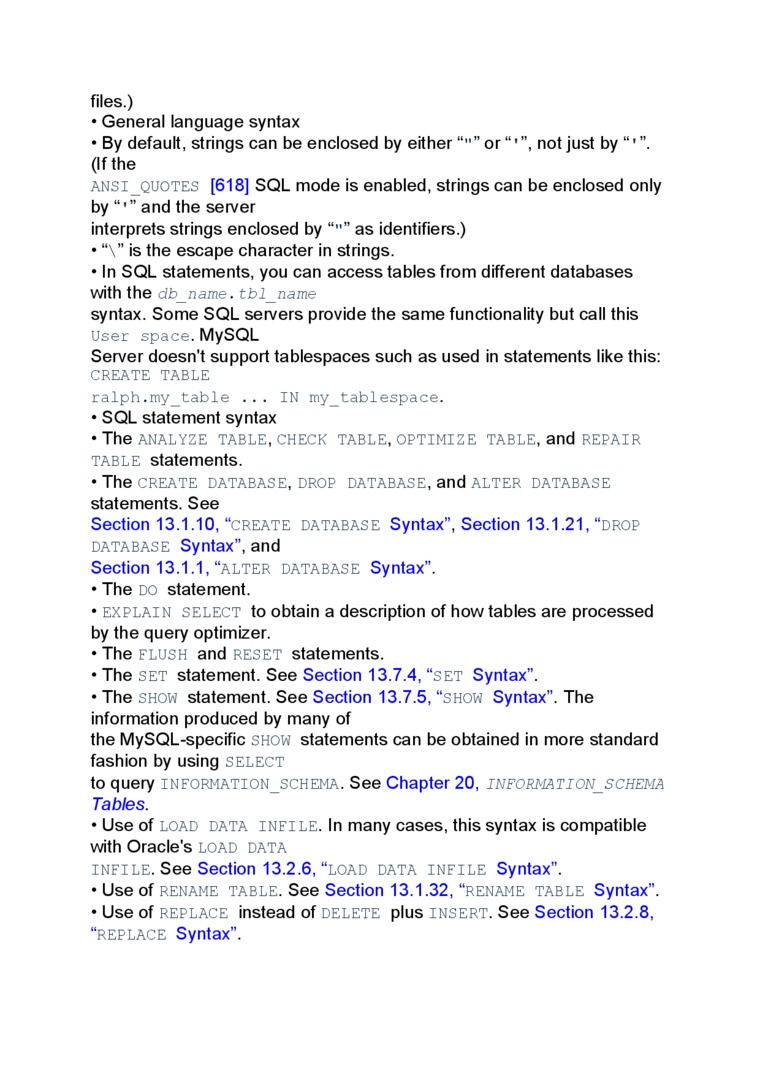79555

files.)
• General language syntax
• By default, strings can be enclosed by either or “' ”, not just by “' (Ifthe
ANSl_QUOTES [618] SQL modę is enabled, strings can be enclosed only by and the server
interprets strings enclosed by as identifiers.)
• “\” is the escape character in strings.
• In SQL statements, you can access tables from different databases with the db_name. tbl_name
syntax. Some SQL servers provide the same functionality but cali this
User space. MySQL
Server doesn't support tablespaces such as used in statements like this:
CREATE TABLE
ralph.my_table ... IN my_tablespace.
• SQL Statement syntax
• The ANALYZE TABLE, CHECK TABLE, OPTIMIZE TABLE, and REPAIR table statements.
•The CREATE DATABASE, DROP DATABASE, and ALTER DATABASE statements. See
Section 13.1.10, “CREATE DATABASE Syntax”, Section 13.1.21, “drop
DATABASE Syntax”, and
Section 13.1.1, “alter DATABASE Syntax”.
• The do State ment.
• EXPLAIN SELECT to obtain a description of how tables are processed by the query optimizer.
• The FLUSH and reset statements.
• The set statement. See Section 13.7.4, “set Syntax”.
• The show statement. See Section 13.7.5, “show Syntax". The information produced by many of
the MySQL-specific show statements can be obtained in morę standard fashion by using select
to query information_schema. See Chapter 20, information_schema Tables.
• Use of load data infile. In many cases, this syntax is compatible with Oracle’s LOAD DATA
infile. See Section 13.2.6, “load data infile Syntax". •UseofRENAME table. See Section 13.1.32, “rename table Syntax”.
• Use of replace instead of delete plus insert. See Section 13.2.8, “replace Syntax”.
Wyszukiwarka
Podobne podstrony:
This command tag number/character string can be defined by user applicatian program. The return mess
Bndging By default, one bridge (brO) is defined and active. In this section you can define additiona
govemed by the CENTOS EULA and the GNU General Public License (GPL) version 2.0. The CENTOS EULA can
The content of the syllabuses can be easily extended by additional materials such as files or hyperl
Changing the Files or Settings Transferred by Modifying the inf Files The default file types, folder
SettingsFoldersand File Types Transferred by Default The following sections deseribe the files, fold
skanowanie0070 (3) Active (productiye) vocabulary refers to language items which can be recalled and
slackJoin the Slack workspace Fiszkoteka Fuli name By default, Slack will use your fuli name — but y
fileloc FlasK MPEG Options Video
grabicqwatch ICQwatch v.G by AciDFIesH -1 11 x 1 S can D etection E nabled W ICQwatch v.C PlaySound
00279 Td306bbd4067db22e643a3d18dff257 281 Experimental Design Models with Random Components The Gen
299 PARK2/FRA6E and Afadin in breast cancer A letessier et al lines can be suppressed by microcell-m
C..A. Mascardi (Orał discussion) Few comments can be added to the contributions by Martinetti and Di
więcej podobnych podstron